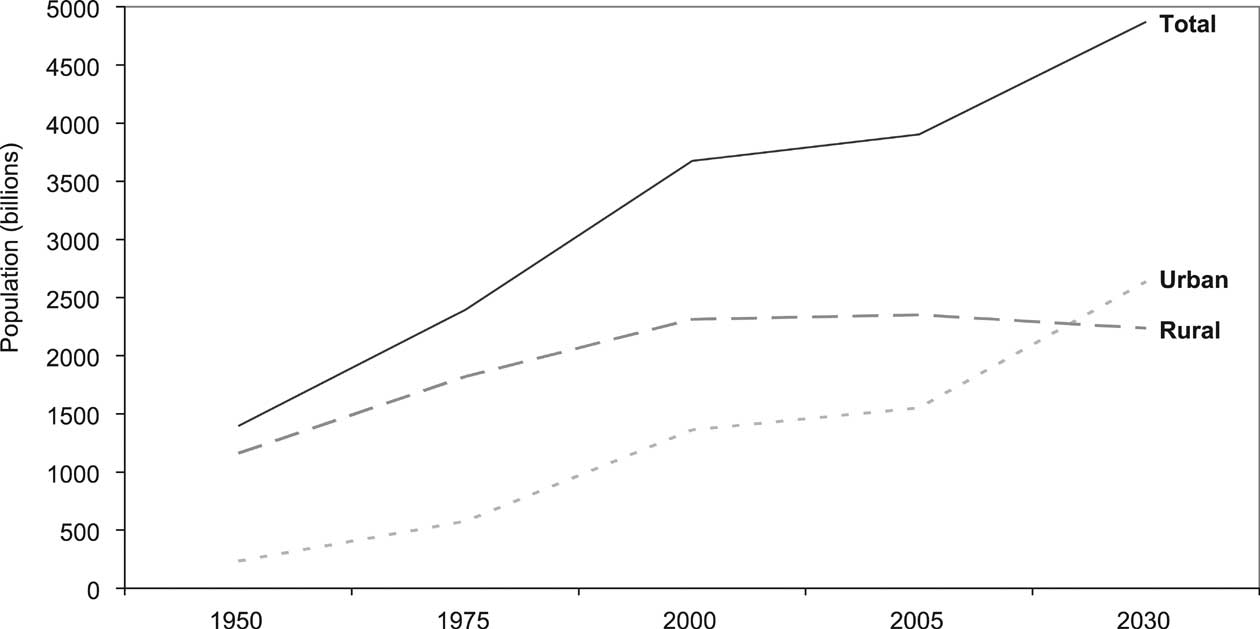availability of food, 46% of children in South Asia will still be malnourished in 2020 (Rosegrant and Malik, 1995). In 2020, South Asia will account for 48% of the world's malnourished children. Progress in improving nutrition is expected to continue, though more slowly than in the past.
Average per capita food consumption in developing countries is projected to rise by 6.3%, from 2680 kcal in 1997-99 to 2850 kcal in 2015. The proportion of undernourished people is anticipated to fall from 20% in 1990-92 to 11% by 2015 and 6% by 2030. However, the 2015 target of halving the total number of undernourished people will probably only be reached in 2030 when the numbers are expected to fall to 440 million. This delay is a result of rapid population growth associated with lagging economic growth as well as the fact that many countries are starting from extremely low national average food consumption levels. The proportion of the global population living in countries with per capita food consumption under 2200 kcal per day will fall to only 2.4% in 2030. However, in South Asia, the fraction could fall by 40% from 1997-99 to 2030 and in East Asia the number could halve by 2030 (FAO, 2003).
The number of malnourished children under the age of five in the developing world is projected to decline by 21% between 1997 and 2020. Although child malnutrition is expected to decline by 31 % in South Asia, India will still be home to 44 million malnourished children in 2020, representing 34% of the total in the developing world. China will have the largest decline, with a 54% reduction in the number of malnourished children by 2020 (IFPRI, 2002).
4.2.1.3 Age structure
The demographic data show ageing in developed countries and an increasing proportion of younger people in most of the developing countries. In India and some other ESAP countries, the younger generation will continue to dominate the labor force for decades. But in China, Japan and the Republic of Korea, family planning policies and improvements in health care will contribute to an ageing of the populations. An ageing population is now one of the crucial social problems being addressed in China (Yuankai, 2007). In the |
|
rural areas in particular, the Government is being forced to acknowledge the need to support millions of senior citizens. Over 60% of China's aged live in rural areas. The number of China's rural senior citizens (i.e., over 60 years old) will reach 120 million in the next 20 years.
Asia is one of the world's fastest ageing regions, with the percentage of elderly projected to double between 2000 and 2030 (Kaneda, 2006). Japan, Australia and New Zealand are expected to see rapid rates of ageing and by 2050 the proportion of people over 60 is projected to be 25% of the population. Ageing presents challenges to agricultural sector productivity and innovation adoption and raises concerns of poverty among the rural elderly and women. Asian developing countries have relatively large youthful populations that require strategies to balance their aspirations with opportunities. A population age structure dominated by youth in developing countries suggests the potential for labor migration to regional developed countries. It also has implications for strong national urban development.
The outlook for the future in the Asian region is for the younger population to increase slowly to 685 million in 2040, when they would account for 14% of the total population. While the growth in the young adult population will continue over the next two decades in the region, in most OECD nations their numbers will decrease (Hugo, 2005). For agriculture, the implication of an increasingly younger population who have development aspirations and who are malnourished (4.2.1.2) is worsened by the emerging gender ratios in the region.
4.2.1.4 Gender composition
A declining labor force (and in particular a declining male labor force) will be available for agriculture, particularly on small to medium farming enterprises and the available labor force will be dominated by women. Due to out-migration of male heads of households, the pressure of maintaining the farm and household will fall on the women left behind despite the constraints they face such as lack of access to land, new seeds and technical knowledge (Paris et al., 2005). The current trends in declining fertility rates are associated with |

